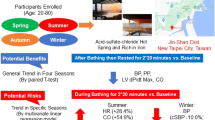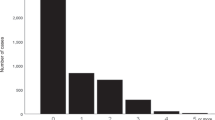Abstract
The Japanese Society of Hypertension has recommended that evening home blood pressure measurement be taken just before bedtime. In this study, to elucidate the influence of nighttime bathing on evening home blood pressure and heart rate, measurements were performed for 7 days using volunteers who were employees of a single company and who had no alcohol intake during the study period. We used data obtained from 158 subjects (78 males and 80 females; mean age, 41.6 years) whose evening data consisted of a combination of pre-bathing and post-bathing measurements. We divided the subjects into four groups according to the time interval from bathing: blood pressure was measured at 30 min after bathing in group I (n=40), at 31–60 min after bathing in group II (n=89), at 61–120 min after bathing in group III (n=74) and at more than 121 min after bathing in group IV (n=53). We evaluated the changes after bathing in each group. For all subjects combined, the evening home blood pressure measured after bathing (114.0±17.1/69.4±10.9 mmHg) was significantly lower than the value before bathing (116.3±17.1/70.7±11.2 mmHg). However, there was no difference in heart rate. Both systolic and diastolic blood pressure after bathing in group I (109.1±15.2/66.3±10.8 mmHg) and II (112.0±15.2/66.5±10.1 mmHg) were significantly lower than those before bathing (group I: 113.2±15.8/70.2±10.6 mmHg; group II: 115.2±15.8/69.3±10.3 mmHg), but these differences disappeared in group III and IV. On the other hand, there was no difference in heart rate after bathing in group I, II, or III, but group IV showed a slight but significant decrease after bathing (67.7±10.0 → 65.8±10.7 beats/min). In conclusion, if evening home blood pressure is to be measured after bathing, subjects should be instructed to wait more than 60 min after bathing before performing the measurement in order to eliminate the depressor effect of bathing.
Similar content being viewed by others
Article PDF
References
Japanese Society of Hypertension Subcommittee for the Management of Hypertension : Guidelines for the Management of Hypertension (JSH 2004). Tokyo, Life Science Publication, 2004, 132 pp (in Japanese).
Asmar R, Zanchetti A : Guidelines for the use of self-blood pressure monitoring: a summary report of the first international consensus conference. J Hypertens 2000; 18: 493–508.
O'Brien E, Asmar R, Beilin L, et al: European Society of Hypertension recommendations for conventional, ambulatory and home blood pressure measurement. J Hypertens 2003; 21: 821–848.
Parati G, Stergiou G : Self blood pressure measurement at home: how many times? J Hypertens 2004; 22: 1075–1079.
Imai Y, Otsuka K, Kawano Y, et al, on behalf of the Japanese Society of Hypertension : Japanese Society of Hypertension (JSH) guidelines for self-monitoring of blood pressure at home. Hypertens Res 2003; 26: 771–782.
Kawabe H, Saito I, Saruta T : Effects of nighttime alcohol intake on evening and next morning home blood pressure in Japanese normotensives. Clin Exp Hypertens ( in press).
Kawano Y, Abe H, Kojima S, et al: Acute depressor effect of alcohol in patients with essential hypertension. Hypertension 1992; 20: 219–226.
Kawano Y, Pontes CS, Abe H, Takishita S, Omae T : Effects of alcohol consumption and restriction on home blood pressure in hypertensive patients: serial changes in the morning and evening records. Clin Exp Hypertens 2002; 24: 33–39.
Moreira LB, Fuchs FD, Moraes RS, Bredemeier M, Duncan BB : Alcohol intake and blood pressure: the importance of time elapsed since last drink. J Hypertens 1998; 16: 175–180.
Kawano Y, Abe H, Kojima S, Takishita S, Matsuoka H : Effects of repeated alcohol intake on blood pressure and sodium balance in Japanese males with hypertension. Hypertens Res 2004; 27: 167–172.
Kawabe H, Saito I, Saruta T : Influence of repeated measurement on one occasion, on successive days, and on workdays on home blood pressure values. Clin Exp Hypertens 2005; 27: 215–222.
Kawabe H, Saito I, Saruta T : Status of home blood pressure measured in morning and evening: evaluation in normotensives and hypertensives in Japanese urban population. Hypertens Res 2005; 28: 491–498.
Joint National Committee on Prevention, Detection, Evaluation, and Treatment of High Blood Pressure : The sixth report of the Joint National Committee on Prevention, Detection, Evaluation, and Treatment of High Blood Pressure. Arch Intern Med 1997; 157: 2413–2446.
Guidelines Subcommittee : 1999 World Health Organization–International Society of Hypertension guidelines for the management of hypertension. J Hypertens 1999; 17: 151–183.
Mengden T, Chamontin B, Phong CN, Luis PGJ, Chanud X : User procedure for self-measurement of blood pressure. First International Consensus Conference on Self Blood Pressure Measurement. Blood Press Monit 2000; 5: 111–129.
Pickering TG, Hall JE, Appel LJ, et al: Recommendations for blood pressure measurement in humans and experimental animals. Part 1: Blood pressure measurement in humans. A statement for professionals from the subcommittee of professional and public education of the American Heart Association Council on high blood pressure research. Hypertension 2005; 45: 142–161.
Tachibana R, Tabara Y, Kondo I, Miki T, Kohara K : Home blood pressure is a better predictor of carotid atherosclerosis than office blood pressure in community-dwelling subjects. Hypertens Res 2004; 27: 633–639.
Ikeda T, Gomi T, Shibuya Y, et al: Morning rise in blood pressure is a predictor of left ventricular hypertrophy in treated hypertensive patients. Hypertens Res 2004; 27: 939–946.
Author information
Authors and Affiliations
Corresponding author
Rights and permissions
About this article
Cite this article
Kawabe, H., Saito, I. Influence of Nighttime Bathing on Evening Home Blood Pressure Measurements: How Long Should the Interval Be after Bathing?. Hypertens Res 29, 129–133 (2006). https://doi.org/10.1291/hypres.29.129
Received:
Accepted:
Issue date:
DOI: https://doi.org/10.1291/hypres.29.129
Keywords
This article is cited by
-
A review of Japanese-style bathing: its demerits and merits
Journal of Physiological Anthropology (2022)
-
Diurnal blood pressure variation and related behavioral factors
Hypertension Research (2011)
-
Electrocardiographic abnormalities and home blood pressure in treated elderly hypertensive patients: Japan home versus office blood pressure measurement evaluation in the elderly (J-HOME-Elderly) study
Hypertension Research (2010)
-
The optimal home blood pressure monitoring schedule based on the Didima outcome study
Journal of Human Hypertension (2010)
-
Determinants of exaggerated difference in morning and evening home blood pressure in Japanese normotensives
Hypertension Research (2009)



